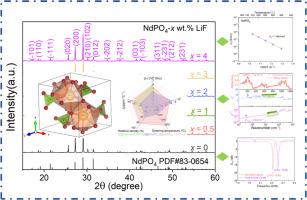用于贴片天线的三元相 Nd2O3-P2O5 基陶瓷的低烧结温度、界面特性和微波/太赫兹介电性能
IF 8.3
2区 材料科学
Q1 MATERIALS SCIENCE, MULTIDISCIPLINARY
引用次数: 0
摘要
本研究选择 LiF 作为烧结助剂,以降低单斜 NdPO4(NPO)陶瓷所需的烧结温度。研究人员对 LiF 对 NPO 陶瓷的烧结特性、微观结构、相组成、结晶结构、界面特性和微波介电性能的影响进行了全面的调查分析。根据密度、晶粒尺寸和晶格应变讨论了结构-性能关系。复阻抗光谱揭示了 NPO 陶瓷上 LiF 界面特性的内在机理。此外,远红外反射光谱和太赫兹时域光谱揭示了 NdPO4-1 wt.%LiF (NPO1) 的固有介电性能。值得注意的是,1 wt.% LiF 有效地将烧结温度从 1300 °C 降低到 850 °C,显著提高了致密性和介电特性。NPO1 陶瓷在 850 °C 烧结后获得了 Q × f = 55,840 GHz(9.58 GHz 时)、εr = 10.4 和 τf = -43.1 ppm °C-1 等典型特性。此外,作为 LTCC 应用的先决条件,还探讨了它与 Ag 的兼容性。最后,NPO1 陶瓷被设计成一种微带天线,在 2.56 GHz 中心频率下具有高增益(6.83 dB)和低回波损耗(-18.85 dB),证明了其在 Wi-Fi 和蓝牙应用中的潜力。这项研究为开发正磷酸盐陶瓷提供了理论基础和实践指导。本文章由计算机程序翻译,如有差异,请以英文原文为准。

Low sintering temperature, interface characteristic and microwave/terahertz dielectric properties of ternary-phase Nd2O3-P2O5 based ceramics for patch antenna application
In this work, LiF was chosen as a sintering aid to lower the sintering temperature required for monoclinic NdPO4 (NPO) ceramic. A comprehensive investigation was conducted to analyze the impact of LiF on the sintering characteristics, microstructures, phase compositions, crystalline structures, interface characteristics, and microwave dielectric properties of NPO ceramic. Structure-property relationships were discussed based on the density, crystallite size, and lattice strain. The complex impedance spectroscopy revealed the mechanism underlying the interface characteristics of LiF on NPO ceramic. Additionally, far-infrared reflectance spectra and THz time-domain spectra revealed the intrinsic dielectric properties of NdPO4–1 wt.%LiF (NPO1). Notably, 1 wt.% LiF effectively reduced the sintering temperature from 1300 °C to 850 °C, significantly improving densification and dielectric properties. Typical properties such as Q × f = 55,840 GHz (at 9.58 GHz), εr = 10.4, and τf = −43.1 ppm °C−1 were obtained for NPO1 ceramic after sintering at 850 °C. Furthermore, its compatibility with Ag was explored as a prerequisite for LTCC applications. Finally, the NPO1 ceramic was designed as a microstrip antenna with high gain (6.83 dB) and low return loss (−18.85 dB) at a centre frequency of 2.56 GHz, demonstrating its potential for Wi-Fi and Bluetooth applications. This work provides a theoretical foundation and practical guidance for developing orthophosphate ceramics.
求助全文
通过发布文献求助,成功后即可免费获取论文全文。
去求助
来源期刊

ACS Applied Materials & Interfaces
工程技术-材料科学:综合
CiteScore
16.00
自引率
6.30%
发文量
4978
审稿时长
1.8 months
期刊介绍:
ACS Applied Materials & Interfaces is a leading interdisciplinary journal that brings together chemists, engineers, physicists, and biologists to explore the development and utilization of newly-discovered materials and interfacial processes for specific applications. Our journal has experienced remarkable growth since its establishment in 2009, both in terms of the number of articles published and the impact of the research showcased. We are proud to foster a truly global community, with the majority of published articles originating from outside the United States, reflecting the rapid growth of applied research worldwide.
 求助内容:
求助内容: 应助结果提醒方式:
应助结果提醒方式:


